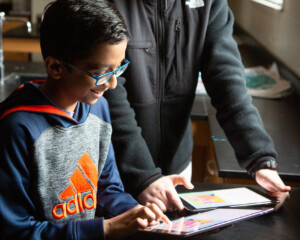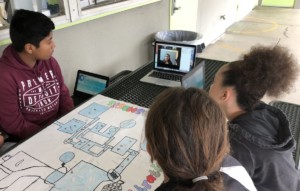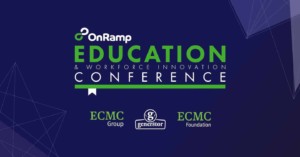Audrey’s Excellent Adventure: Top 10 EdTech Startups
 Audrey Watters was prolific this year. In our book, she wins the top edtech startup reporter of the year award. We are impressed with the ground she covers and the innovators she uncovers. Here’s a terrific year end summary of startups that appeared on her site Hack Education on December 18. Thanks for a big contribution in 2011 Audrey!
Audrey Watters was prolific this year. In our book, she wins the top edtech startup reporter of the year award. We are impressed with the ground she covers and the innovators she uncovers. Here’s a terrific year end summary of startups that appeared on her site Hack Education on December 18. Thanks for a big contribution in 2011 Audrey!
Top 10 Ed-Tech Startups of 2011
I think it’s clear by now — whether you’ve read my series on the top ed-tech trends of 2011 or not — that it’s been a big year for education technology startups. Launches. Updates. Funding. Acquisitions. Adoption. Headlines. Buzz. Woohoo. And stuff.
Even with all these developments, making a list of the best new education technology startups is challenging — and not just because there were a lot of great companies to choose from. It’s challenging because of definitions: what counts as an “education startup”? Evernote and Twitter, for example, are two tools popular among teachers and students. But do they count as education companies? And hell, do they even count as startups?
I’m not going to define what counts as “education” or “ed-tech” here. But to narrow the field, I’m just highlighting startups that were founded and/or launched in 2011. I realize that overlooks a lot of older new companies that have had a phenomenal year: Edmodo‘s stunning growth,Knewton‘s sizable funding round, for example.
But really, that’s it for my rubric. This isn’t some scientifically constructed list of the startups with the most registered users or most revenue or most popular iPad apps or most mentions in my writing. I chose each of these companies for lots of different reasons (reasons I explain as I highlight them in turn): great technology, great product, great solution, great vision, great founders.
So in no particular order…
1. Launchpad Toys
 I’ve had a lot of meetings with educators and entrepreneurs this year. But just one person has ever cited Seymour Papert in a casual conversation over coffee, and that’s Launchpad Toys‘ co-founder Andy Russell. It wasn’t just a passing mention either. I think Papert’s work and ideas about constructionism permeate a lot of what the startup does, and Launchpad Toys is committed to creating a learning experience with and through digital storytelling that I’ve not see elsewhere. The company is also committed to building high quality yet affordable educational apps (See The Children’s App Manifesto, which Russell co-authored).
I’ve had a lot of meetings with educators and entrepreneurs this year. But just one person has ever cited Seymour Papert in a casual conversation over coffee, and that’s Launchpad Toys‘ co-founder Andy Russell. It wasn’t just a passing mention either. I think Papert’s work and ideas about constructionism permeate a lot of what the startup does, and Launchpad Toys is committed to creating a learning experience with and through digital storytelling that I’ve not see elsewhere. The company is also committed to building high quality yet affordable educational apps (See The Children’s App Manifesto, which Russell co-authored).
Launchpad Toys’ first app Toontastic is a cartoon creation tool. Toontastic helps children think through story elements: the characters, the conflict, setting, scenes and so on. Then, when they are ready to animate their story, they press record. The microphone captures kids’ narration, as they use their fingers to animate the characters on the storyboard.
Launchpad Toys launched in August, a graduate of the summer Y Combinator batch. The startup has won numerous awards and accolades this year, most recently selected by Apple as one of its top education iOS apps of the year.
2. Desmos
 Desmos is building software that will address one of the major problems that classrooms are going to face: hardware fragmentation. Some schools have invested in interactive whiteboards. Some have bought netbooks or tablets. Some provide iPod Touches, and some let students bring their own devices. With all these various hardware options, it’s becoming increasingly important to have software that’s platform agnostic — something that students and teachers can use at home and at school, something that works and is still full-featured on any device.
Desmos is building software that will address one of the major problems that classrooms are going to face: hardware fragmentation. Some schools have invested in interactive whiteboards. Some have bought netbooks or tablets. Some provide iPod Touches, and some let students bring their own devices. With all these various hardware options, it’s becoming increasingly important to have software that’s platform agnostic — something that students and teachers can use at home and at school, something that works and is still full-featured on any device.
Desmos launched onstage at Techcrunch Disrupt in May. But when I chatted with founder Eli Luberoff a few weeks later, he showed me something that made me even more excited about this company’s potential (and I say this as a person who is deeply committed to technologies that work across platforms).
See, Desmos has built a web-based graphing calculator. Ah, the graphing calculator, that one piece of computing hardware that — despite all the handwringing about BYOD — kids are required to buy and bring to class. A low-end graphing calculator will cost you about $70. Desmos’ calculator is free, and it contains features that you won’t find elsewhere (such as dotted lines for inequalities).
Sometimes it seems as though education companies think they just deserve customers (Texas Instruments, I’m looking at you) without doing much to improve or innovate, without really thinking about their users as learners. Desmos’ graphing calculator wasn’t built to prop up revenue for an outmoded company; it’s a cool product (a side project, true, but part of a much larger Web-based effort), built by math geeks who want awesome, affordable, and accessible math tools.
I covered Desmos here. [also see Desmos Introduced at TechCrunch Disrupt and Coleen Young’s post on Desmos Graphing Calculator]
3. LittleBits
 While I love the way in which the Maker Movement has blossomed this year, I sometimes worry that interest in science, engineering and tech will continue to leave girls out of the loop, particularly when it does to hardware tinkering. It doesn’t help when organizations say things like “Arduino: so easy your mom could do it.”
While I love the way in which the Maker Movement has blossomed this year, I sometimes worry that interest in science, engineering and tech will continue to leave girls out of the loop, particularly when it does to hardware tinkering. It doesn’t help when organizations say things like “Arduino: so easy your mom could do it.”
So yes, it matters to me that the founder of littleBits is a woman.Ayah Bdeir is also an engineer and an artist, and I think that sensibility — STEM + the Arts — shines through in her company.
LittleBits offers a library of pre-assembled circuit boards that snap together with tiny magnets. There’s no soldering, no wiring and no programming required. The circuit boards in a littleBits kit have unique functions � a power component, a pressure sensor, a button, for example � that can simply be snapped together. Soldering is fun, I won’t lie, but it’s intimidating, and as such littleBits lowers the barrier to entry for those interested in working with electronics.
And okay, I’m fudging a bit on my “founded in 2011” rule here, as this idea has been a work-in-progress for several years. But you can now buy littleBits kits, and the startup did raise its first round of funding this year. I covered the littleBits here.
4. General Assembly
 New York City’s General Assembly sits at the nexus of several important education/technology trends (See: “STEM Education’s Sputnik Moment” and “The Higher Education Bubble“.) New York City is building a vibrant tech community — [insert obligatory comparison to Silicon Valley here. Roll eyes and mutter that New York’s different, bigger, better, faster, stronger]. As such, there’s a high demand in New York for talent, and in turn, a high demand for learning opportunities (formal and informal), instruction, and mentorship about what exactly it entails to build a technology startup. Coding, design, marketing, CEOing, and stuff.
New York City’s General Assembly sits at the nexus of several important education/technology trends (See: “STEM Education’s Sputnik Moment” and “The Higher Education Bubble“.) New York City is building a vibrant tech community — [insert obligatory comparison to Silicon Valley here. Roll eyes and mutter that New York’s different, bigger, better, faster, stronger]. As such, there’s a high demand in New York for talent, and in turn, a high demand for learning opportunities (formal and informal), instruction, and mentorship about what exactly it entails to build a technology startup. Coding, design, marketing, CEOing, and stuff.
General Assembly uses the word “campus” to describe its facilities. And that’s the sense you get too: a library, a communal work- and learning space. General Assembly, which opened its doorsat the beginning of the year, offers classes on engineering and entrepreneurship. The site also offers workspace to rent, and several startups who do so help teach some of the classes that are offered.
With all the hullaballoo of online education and online work, having a physical location to go to to learn and work still matters. It matters for building skills; it matters for building community.
I covered General Assembly here. [Also see Anya Kemenetz interview with Tom on GA, a Brad Hargreaves story GA: A Place of Learning, and a summary of Tom’s visit to General Assembly]
5. Highlighter
 I remember the very first time a teacher gave me permission to write in a book. Highlight important passages, she said. Make notes in the margins. No way, I thought. You can write in books?!
I remember the very first time a teacher gave me permission to write in a book. Highlight important passages, she said. Make notes in the margins. No way, I thought. You can write in books?!
Since then, I’ve read every book with a pencil in hand — underlining and annotating. That’s something that makes the move to digital books both terrifying and wonderful. It’s terrifying if indeed it means the end of marginalia. And it’s wonderful if someone can build a tool that integrates marginalia with the Web, and makes our notes and highlights sharable and social.
The Seattle-based startup Highlighter has done just this, with some easy-to-implement Javascript that enables commenting “in the margins” of websites. While there were a number of new social reading startups this year, Highlighter is targeting academic communities in particular, working closely with college professors to build a reading tool that’s useful for both teachers and learners (with features like groups for classes and discussions.)
One of the problems about reading and annotating digital content is that much is locked down, in proprietary formats. Highlighter is building an HTML 5 e-reader and supports OER and open platforms for reading and note-taking.
Highlighter was part of the Seattle-based Techstars incubator and launched this summer. I covered Highlighter here, here, and here.
6. Celly
 Here’s the thing: the technology matters. I mean, it matters in general. Yes of course. But when it comes to ed-tech, damn, I think we should set our standards pretty high. And frankly, we need to be better about looking under the hood, if you will, of the tools we adopt.
Here’s the thing: the technology matters. I mean, it matters in general. Yes of course. But when it comes to ed-tech, damn, I think we should set our standards pretty high. And frankly, we need to be better about looking under the hood, if you will, of the tools we adopt.
Looking under the hood makes me like Celly a lot. Its co-founders Russell Okamoto and Greg Passmore, both former software architects at VMWare, have both the technical chops and the smarts to think about building networks in a new way.
I say this, of course, in a year in which “group messaging startups” were hot — good grief, you say, another mobile messaging network?! But Celly was part of a different kind of messaging trend, one that I called out as one of the most important ed-tech trends of the year: text-messaging. SMS.
SMS is important in education, I would argue, because it’s the best tool we have right now to bridge the digital divide. Most people have access to SMS via their cellphones. Most people. Most parents. Most students. SMS can be a powerful communication device between school and home, between teacher and student, between students and class, between classes and the community.
We saw an explosion in the number of ed-tech startups this year that moved to address opportunities with text-messaging apps (hence the trends post). But I feel as though Celly might just have the technological edge here. Celly offers a communication tool, sure. It builds community, yes. But it’s not just teachers broadcasting messages to home. There are multiple ways in which the “cells” can be configured — curating messages (from RSS as well as from people’s text messages) to spread out to others in the community or to filter up the chain of command.
I wrote about text-messaging a lot this year, but I specifically covered Celly here.
7. GoalBook
 Don’t make me pick a favorite piece of technology journalism from 2011, folks. I’m getting sick of writing “Best of” stories. But one of my favorite pieces was Tim Carmody’s response to the death of Steve Jobs: “This Stuff Doesn’t Change the World.” As Tim makes clear, this stuff does change our worlds — his autistic son’s usage of the touchscreen iOS devices case in point. Tim’s tweet — “I’m on my way to PHL to see my son, who uses a device Steve Jobs invented to help him talk. He will never know. He will never know.” — sits in my heart every day when I think about our obligations to build accessible, affordable, world-changing technology.
Don’t make me pick a favorite piece of technology journalism from 2011, folks. I’m getting sick of writing “Best of” stories. But one of my favorite pieces was Tim Carmody’s response to the death of Steve Jobs: “This Stuff Doesn’t Change the World.” As Tim makes clear, this stuff does change our worlds — his autistic son’s usage of the touchscreen iOS devices case in point. Tim’s tweet — “I’m on my way to PHL to see my son, who uses a device Steve Jobs invented to help him talk. He will never know. He will never know.” — sits in my heart every day when I think about our obligations to build accessible, affordable, world-changing technology.
You hear a lot about the ways in which mobile, touchscreen devices open up new worlds for those with disabilities. But despite the great promise, software and hardware development for assistive technology and for special education doesn’t get a lot of attention. It doesn’t get sufficient attention in consumer tech or in classroom tech.
One of the things I love about Goalbook then, is that it is addressing something that’s tough and complicated and bureaucratic and frustrating about special education in schools — just the sort of thing that technology should help address, but quite frankly, often fails to. So Goalbook founders Daniel Yoo and Justin Su have taken on an important challenge.
Goalbook is building a system to help schools handle IEPs (individualized education programs). These can become incredibly complex when a student has special needs, so much so that it’s easy to fumble with communication and lose track of student’s goals. Goalbook allows the team that works with a student (and that team can include parents, primary teachers, behavioral specialists, administrators, speech therapists, and so on) to better communicate and collaborate in helping support the student’s personal learning goals.
The Goalbook founders are both educators and engineers — and they’re building this startup to address a real need they’ve experienced in their teaching careers. Goalbook is still in beta with a few pilot schools.
8. DuoLingo
 Even before the startup launched, MG Siegler headlined his story on it Meet Duolingo, Google’s Next Acquisition Target. His confidence is hardly unfounded, based on the track record of Duolingo founderLuis von Ahn whose research has already been acquired by Google twice: the ESP Game and reCAPTCHA.
Even before the startup launched, MG Siegler headlined his story on it Meet Duolingo, Google’s Next Acquisition Target. His confidence is hardly unfounded, based on the track record of Duolingo founderLuis von Ahn whose research has already been acquired by Google twice: the ESP Game and reCAPTCHA.
Duolingo is very much in the same spirit as these projects insofar as it utilizes human micro-tasks “for good” — in order to help identify and verify information that computers cannot yet process.
We creatures of the Web fill out a lot of CAPTCHAs, and some 750 million users have helped Google’s book digitization efforts by using reCAPTCHA to help correct OCR misreads. Now, with Duolingo, von Ahn hopes to be able to use a similar sort labor in the wonderful and mammoth goal of translating the Web into all major languages.
Duolingo is couched in terms of language learning, and I’m not quite sure that’s the right description for the project — in other words, using Duolingo alone is unlikely to be your path to German fluency. (Although maybe more will come of the language-learning component — Duolingo is still in beta). Nevertheless I love the idea of this type of crowdsourced effort, and I think the possibilities for learning through micro-tasks is fascinating.
I covered Duolingo here.
9. Raspberry Pi
 The dream of putting a low cost computer in the hands of every kid is hardly a new one. But what the British charity Raspberry Pi has in mind does one better than simply giving kids a $200 laptop.
The dream of putting a low cost computer in the hands of every kid is hardly a new one. But what the British charity Raspberry Pi has in mind does one better than simply giving kids a $200 laptop.
Raspberry Pi has build a $35 single-board computer.
A what, you ask?
Yeah. Exactly. See, that’s part of the problem.
Raspberry Pi isn’t really a hardware manufacturing startup (although yes it’s manufacturing hardware). It’s an educational non-profit based in the UK, one that “exists to promote the study of computer science and related topics, especially at school level, and to put the fun back into learning computing.”
What Raspberry Pi has built is an ultra-small, ultra-low cost device: a board the size of a credit card that contains a fully functional computer system. Some 700 MHz of processing power, 256 MB of RAM, OpenGL and Blu-ray-grade playback (1080p), HDMI and audio outputs, a USB port, a Flash memory car slot, 100MB Ethernet. That’s all on a card that’s powered by a 5V supply. And for a cost of just $25-35.
And what do you do with something like that, you ask? You hack.
The Raspberry Pi computer will run Linux… and from there, Scratch… and from there, well, the possibilities for computer education are endless. The first of the Raspberry Pi cards are hitting shelves this month.
10. LessonCast
 If there was one question I asked education startups repeatedly this year, it was “Have you talked to any teachers?” (You’d be surprised — perhaps — by how often the answer was “No.”) No doubt, it might be easier to do so and it might be easier to recognize both problems and solutions, when the founding team is comprised of educators.
If there was one question I asked education startups repeatedly this year, it was “Have you talked to any teachers?” (You’d be surprised — perhaps — by how often the answer was “No.”) No doubt, it might be easier to do so and it might be easier to recognize both problems and solutions, when the founding team is comprised of educators.
I met the LessonCast founding team at a Startup Weekend EDU in San Francisco this summer. Nicole Smith and Katrina Stevens are both Baltimore-area educators, and Khalid Smith, Nicole’s husband, an engineer (he has since become the education director for Startup Weekend’s new EDU vertical).
When Nicole pitched the idea of Lessoncast at Startup Weekend EDU, I loved it: it’s a tool to help teachers quickly create and easily share lesson ideas and classroom management tips in a video format. Indeed, with all the fuss about Khan Academy, making video lessons is still fairly complicated and time-intensive. But LessonCast isn’t really hopping onto the “flipped classroom” bandwagon. This isn’t (necessarily) about teaching students; it’s about teachers teaching each other, sharing tips and tricks and advice and ideas. The tool is about building and sharing PD — a process that is about teaching and learning for the creator of the lesson as much as the viewer.
I covered the startup here.
P.S. I left a lot of great startups off this list. I’m now officially sick of writing “Top 10” stories. And I’m now officially done with 2011’s…





0 Comments
Leave a Comment
Your email address will not be published. All fields are required.